Platform "Kurganets-25" and "Boomerang." Layouts and assumptions
Until a certain time, information about new platforms was extremely scarce and consisted of a couple of phrases spoken by representatives of the Ministry of Defense and Industry. Thanks to these statements, approximate characteristics of future cars became known. It should be noted, sometimes called indicators significantly changed, although some general direction of development was traced. In the last days of the past June, several interesting images came into free access. On the site of the company Modellmix, engaged in the manufacture of souvenirs (including models of military equipment) appeared photos of alleged models of cars based on the "Kurgants-25" and "Boomeranga." Soon, these photos were removed from the site, but fans of military equipment managed not only to save them, but also to “subject” them to wide distribution. Previously, the public had at its disposal several computer 3D circuits, which depict the appearance and the approximate internal layout of the above machines. These information leaks were the first cases in stories domestic platforms, when the public became known at least the approximate appearance of future technology. Of course, the next wave of discussions and attempts to find out a little more than depicted in the diagrams and photos began.
Kurganets-25
The first of the while mysterious platforms. It is assumed that this will be the average weight of the armored vehicles, and their approximate combat weight in tons is reflected in the project name - 25000 kg. Only this fact and the type of Kurgants-25 propeller are reliably known. It was immediately announced that this platform would be tracked. Based on this fact, assumptions began to appear regarding the possibility of creating a certain type of technology based on this platform. Obviously, the average tracked platform can carry equipment for the evacuation of its "relatives" (option BREM), can be the basis for an ambulance, for command and staff, as well as transport equipment for communication or for other work with the air - it can be radio intelligence or electronic warfare. Finally, the entire internal volume can be given under the seats for personnel and thus make an armored personnel carrier or an infantry fighting vehicle. In the latter case, most likely, you will have to sacrifice volumes to install a serious combat module like “Bakhchi”. In general, the list of vehicles based on a platform with a combat mass of about 25 tons is limited only by the needs of the military and the capabilities of the industry.
On the photographs of the layout that hit the Internet, the alleged Kurganets-25 is designed as a command and staff vehicle (KSHM). If the layout is really a plastic embodiment of the project, then the platform looks like this. Armored hull, assembled from straight panels, can be divided into two parts: the engine compartment and the habitable volume. MTO is located in the front of the machine, with a shift to the right. The engine and transmission transmit power to the tracks using front wheel drive. Such an arrangement, it should be noted, has been successfully used on domestic infantry fighting vehicles for many years. Not surprisingly, the military demanded from the very beginning the possibility of disembarking through the door in the rear of the armored vehicle, and with such wishes there were not so many options for layout. As we see, the engineers of Kurganmashzavod chose the one of them that allows you to place the workplaces of all crew members in the same volume, without their separation, as it was, for example, on the German BTR TPz 1 Fuchs. Thus, the mechanic-driver of the combat vehicle is located in the same compartment with the other crew, but for landing and disembarking he has his own hatch. The rest of the soldiers rely door in the back of the machine. It is noteworthy that on the published Kurgants-3 25D model, this door is attached to the bottom case, i.e. the machine has not just a sash to close the opening, but a ramp for the landing of the troops or the crew.
On the roof of the “illuminated” CMR model there are two long antennas and two smaller ones. Such a set is quite understandable in the light of the purpose of this class of technology. In addition, from the available photos you can get an idea of the internal equipment of the command and staff machine based on the "Kurgants-25". Inside the building there are two relatively large tables for the target equipment, a cabinet for additional equipment, as well as four seats for personnel. At the same time, five seats for the crew are noticeable on the 3D model. Perhaps the layout and three-dimensional "image" refer to different iterations of the project, if not the fruit of two different fantasies. Anyway, in both cases, the internal volumes allow you to place both people and equipment with a certain comfort.
The second model, whose photos turned out to be publicly available, is a miniature embodiment of the Kurganets-Palantin-P mobile command and control center. In its overall layout, it somewhat resembles a CMR, with the difference that it does not have so many different antennas and roof trusses. Inside the layout, there are cabinets for equipment of much larger volume and only two crew jobs. Probably, this time the lack of volume inside the armored hull still affected. Regarding the equipment that will be equipped with the control and reconnaissance machine or the KSHM, one can only guess. Even after the “Kurganets-25” will be put into mass production, for some time the composition of the target equipment will be secret for some time.
However, a more interesting and promising option "Kurgants-25" looks like an infantry fighting vehicle based on it. Most likely, this BMP will be equipped with a combat module "Bakhcha", developed in Tula KBP. It is likely that Tula engineers are already in full swing creating a new weapon system for light and medium armored vehicles, but at the present time only one module has been brought. Accordingly, Bakhcha is still the only contender for the “position” of combat equipment of a promising infantry fighting vehicle. This version is supported by the fact that the chairman of the board of directors of Kurganmashzavod, A. Bakov, in May promised to complete the preparation of the project and the construction of a prototype by the end of 2012. Most likely, already in December we will receive the first photos of a prototype of a new infantry fighting vehicle. Then it will be possible to draw the first conclusions regarding today's assumptions.
Command Headquarters based on Kurganets-25:
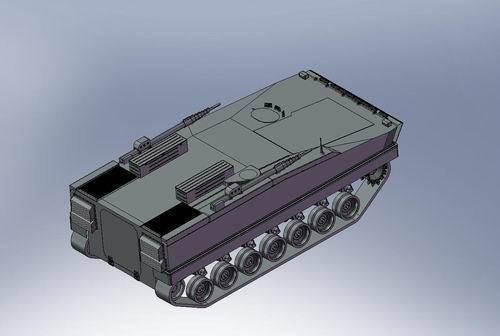
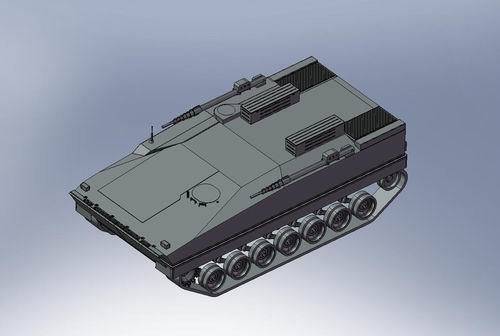
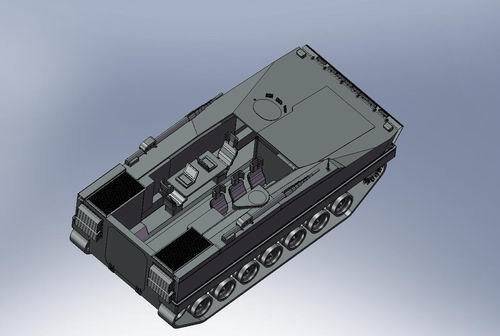
Point of Management and Intelligence (PUR) "Palantin-P" based on "Kurganets-25":
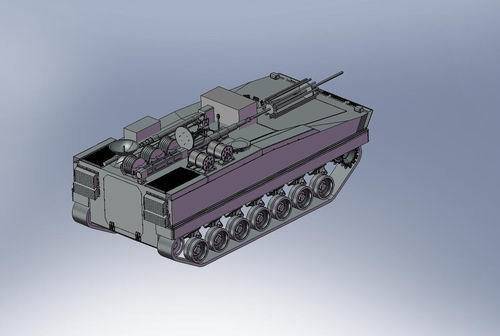
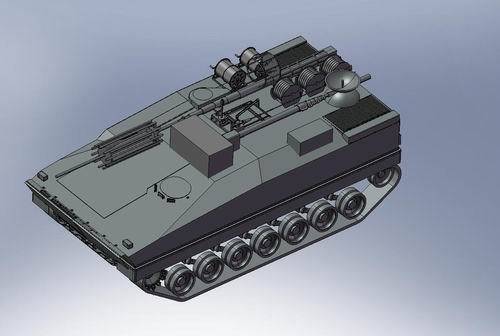
"Boomerang"
That same autumn, 2010 became aware of the beginning of the development of another medium platform, this time a wheeled platform. Machines of the “Boomerang” family will have to have a wheel formula 8х8 and a combat weight of about twenty tons. As in the case of the Kurgants-25, the wheeled platform must have doors for the crew in the rear, sufficient manned volume and the ability to ensure the functioning of the various systems that are needed by a particular machine. The set of requirements eventually led the design team of the Military Industrial Company to the original solution. Due to the need to place the door in the rear of the car, the engine was moved from the rear to the front and middle. Under the engine and transmission mechanisms reserved "box" of a large size. Moreover, judging by the photos of the “Boomerang” layout, it does not occupy the entire width of the vehicle, but only part of it. Between the left wall of the case and MTO there is a small manhole. It is alleged that through him the mechanic-driver of the armored vehicle will be able to leave his place if it is impossible to do so through his own hatch.
As a matter of fact, such an original and unconventional decision for the domestic defense industry became the “cornerstone” of the project. Because of it, the placement of the engine in the right front of the case entails a lot of questions. For example, among fans of military equipment, there are now active disputes regarding the summing up of power to all wheels. Obviously, the new location of MTO simply will not allow the use of old practices. In addition, the cause of questions and doubts is a fairly large amount of the motor compartment. This feature of the design is sometimes perceived as the basis for the version of the placement of any additional unit, for example, an electric generator. In the case of machines that must be equipped with a large number of electronics, the generator will definitely not be superfluous. Finally, another reason for dispute are two water jets. At the back of the layout, two pipes with screws inside are clearly visible. How power is supplied to them is not yet clear.
It is worth noting that the specific layout of the internal organs of the Boomerang cannot but affect the ergonomics of the habitable volume. In the photo of the KSHM model on the wheeled chassis, you can see the approximate proportions of the actual volume and the approximate size of the seats for personnel. If in the configuration of an armored personnel carrier to place the seats for the landing on the sides, then in the landing compartment you can write 8-10 seats. For landing and leaving the car, regardless of the configuration, the crew has a large folding ramp (down) located on the stern armor sheet. Interestingly, the ramp is quite clearly visible door of a smaller size, opening to the right (when viewed from the outside). The driver, in turn, has its own hatch above his workplace.
As in the case of the Kurgants-25, the Boomerang models were made in two versions: a command and staff vehicle and a complex of electronic intelligence and suppression. The layout of the habitable volume in the case of the KSHM layout is similar to the placement of jobs and equipment of the corresponding version of "Kurgants-25". There are probably some differences, but in the existing photographs both compartments look very, very similar. In addition, four antennas are placed on the roof of the Boomerang CSR, two of which are larger than the others. Obviously, during the development of two cranes, the designers had to enter the same communications and control equipment into the body of the armored vehicle: this can explain the greater degree of similarity of the interiors.
On the stand of all layouts there are signs with a description. It was these details that made it possible to relatively quickly and accurately determine the purpose of the machines that became the prototypes for the models. The quality of photographic materials leaves much to be desired, but the second layout of the “Boomerang” was also identified. It is alleged that this is a mobile complex of electronic intelligence and electronic warfare "Boomerang Infauna." This car differs from KShM first of all in the appearance. Instead of telescopic antennas, this complex is equipped with a special emitter of the original design. In the working position, the antenna of the complex "Infauna" rises on a sliding rod. Obviously, this node is not able to somehow develop and change its dimensions. Therefore, in the traveling position, the antenna is located inside the octagonal armored structure on the roof of the vehicle. It is this shield is a characteristic feature of the machine "Boomerang Infauna." As for the target equipment, then, as before, its location is very much like the machine "Kurganets-Palantin-P".
The machine of the multifunctional complex of electronic warfare "Infauna" based on "Boomerang":
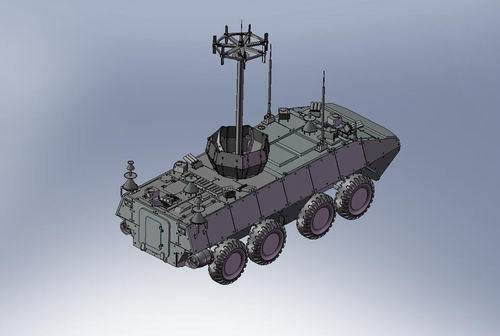
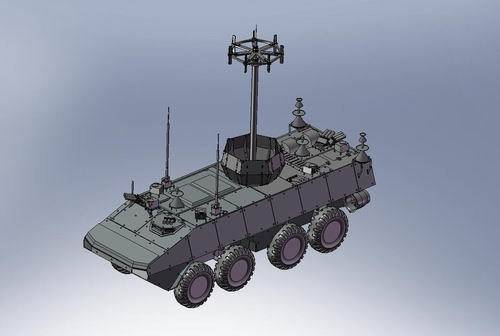
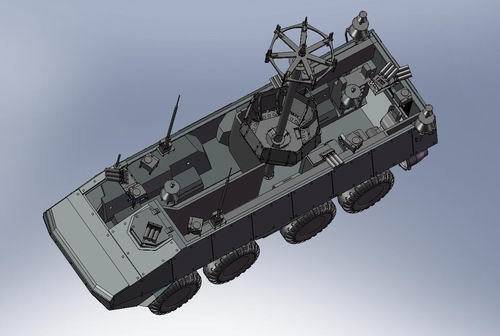
Command-based vehicle based on "Boomerang":
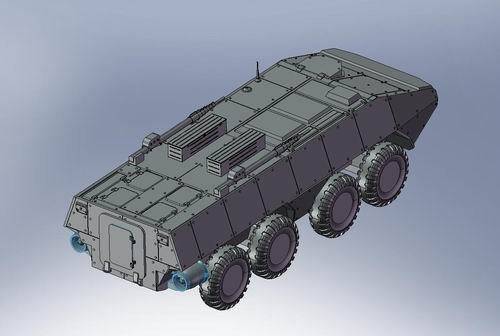
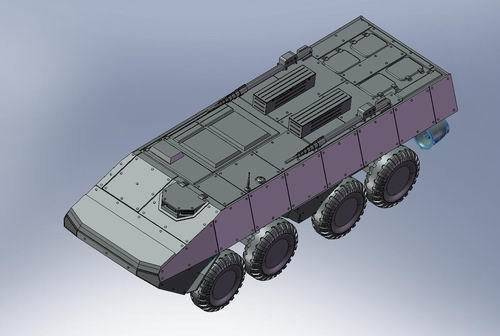
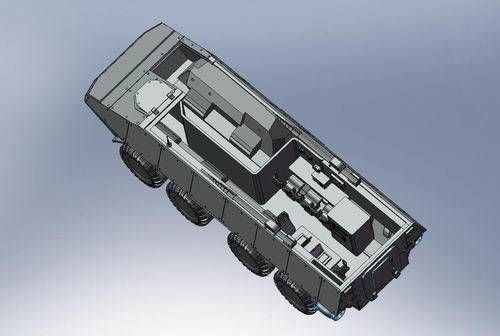
Machines and deadlines
As we see, already at this stage the project looks quite mature and elaborated. Obviously, both Kurganets-25 and Boomerang currently have their drawbacks. Nevertheless, there are trials for their detection, and for correction there is a time for fine-tuning. So it is quite possible that by the time the first prototypes are ready, the design documentation will be devoid of the overwhelming majority of problems and shortcomings. If all the existing photos and 3D-models have any relation to real projects, then the big questions are how exactly the designers were able to put together all the demands of the military. First of all, the issues are caused by the front engine and transmission. The fact is that the use of such an arrangement shifts the center of gravity of the machine forward. For a purely land vehicle, this is uncritical, but floating can have problems with stability when moving on water. As for the Boomerang MTO, here everything looks even more complicated: the engine of this machine is not only located in front, but also strongly shifted relative to the longitudinal axis. If you look closely at the design of the photographed layouts, then without much difficulty you can find a few more problems of varying degrees of complexity.
Since the first announcement of the programs "Kurganets-25" and "Boomerang", the timing of their implementation has practically not been adjusted. Prototype samples are still scheduled to be sent for testing early next year. Next a couple of years will be used to fine-tune the machines and prepare for mass production. The military intend to receive the first vehicles based on the Boomerang and Kurganets-25 platforms in the same 2013 year. Full compliance with these deadlines is possible only if the designers of Kurganmashzavod and the Military Industrial Company not only know about the existence of the minuses of their chosen solutions, but have already coped with them. One way or another, it will be possible to speak with great precision about the prospects of projects only at the end of this year, when both organizations finish assembling prototypes.
On the materials of the sites:
http://gurkhan.blogspot.com/
http://twower.livejournal.com/
http://militaryrussia.ru/
http://odnako.org/
Information